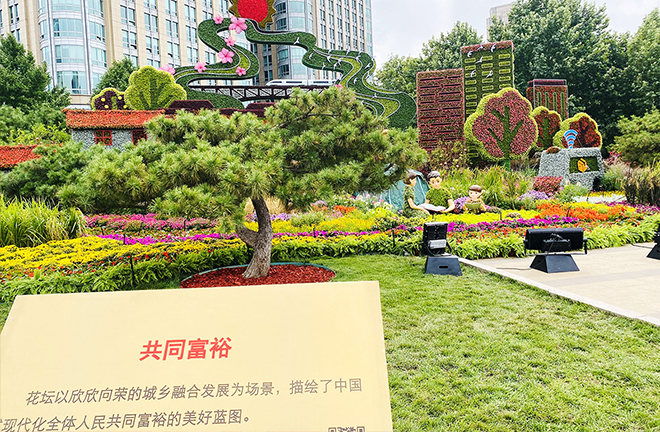China’s common prosperity conducive to global prosperity

A “common prosperity” parterre at Dongdan, Beijing, on Sept. 27 Photo: Chen Mirong/CSST
As China strives to achieve common prosperity for all, global academia has been paying close attention to this uniquely Chinese concept and project, particularly scholars specializing in studies of prosperity. Recently, CSST interviewed Maurizio Marinelli, an honorary professor from the Institute for Global Prosperity at the University College London in the United Kingdom, to discuss China’s notion of common prosperity and its significance on a global scale.
Theoretical highlights
Tracing the origins of the term “common prosperity,” Marinelli pointed out that it can be traced back to one of the three “great differences” identified by Chairman Mao Zedong: the difference between the city and the countryside. In the Resolution on the Development of Agricultural Production Cooperatives adopted in December 1953, Mao introduced the concept of “common prosperity” as a goal of socialist construction: to enable farmers to gradually get rid of poverty and achieve common prosperity and a generally prosperous life.
At the 10th meeting of the Central Financial and Economic Commission on August 2021, General Secretary of the CPC Central Committee Xi Jinping further clarified the concept in his speech on making solid progress toward common prosperity, stating “The common prosperity we are working to achieve is for everyone, and covers enrichment of people’s lives in both the material and non-material sense. It is not prosperity for a minority, nor is it rigid egalitarianism.”
In the 27th group study session of the Political Bureau of the 19th CPC Central Committee in January 2021, Xi demanded further steps to meet the needs of rural areas, primary organizations, underdeveloped areas, and disadvantaged groups in the pursuit of common prosperity.
“This is quite a significant clarification, with a strong emphasis on rebalancing the wealth gap, not only ‘making the pie bigger,’ but also making the slices accessible to a wider percentage of the population,” Marinelli said. Xi Jinping presented the ambitious common prosperity program using the metaphor of an ‘olive-shaped’ income structure: as a result, the middle-income group would progressively become larger, while the poorer stratum and the rich one smaller, he added.
Domestic and global significance
In Marinelli’s view, the dream of common prosperity entails a very ambitious vision and requires a programmatic strategy. At the national level, it can be interpreted in three ways: first, as an imperative necessity resulting from the continuously widening wealth gap; second, as an ambitious program aimed at income redistribution that would require new domestic economic policies such as redistributive fiscal policies, labor and product market policies; and third, as a possible new pathway to national socio-economic prosperity, which could also be part of a wider international heterotopic dialogue on rethinking economics and looking for alternatives to previous growth strategies that are more in line with wellbeing economics, circular bioeconomy, and regenerative economy.
“The current thinking around prosperity tends to emphasize post-neoliberal and post-GDP economics, prioritizing environmental sustainability and drawing on de-colonial and post-development theories. As valid as these approaches can be, they remain largely rooted in Western concepts that fail to reflect both the global demographics and the interconnectedness of global political-economic and socio-ecological challenges,” Marinelli said.
Given China’s resurgence in the global geopolitical and economic sphere, he stressed that understanding the concept and pathways to prosperity in China has become particularly important. It requires an in-depth analysis of the interconnectedness between the economic and social value systems, taking into consideration the country’s specific historical conjunctures and philosophical-cultural background. “Furthermore, when one considers the current global challenges, and more specifically the current weaknesses in the global economy and geopolitical security, China’s pathway to prosperity is indeed crucial for global prosperity,” he said.
“Through the study of global prosperity, we have realized that one of the major challenges for prosperity is the possible disconnection between policy-politics imagery and the community’s imagery of a better life, based on their lived experience,” Marinelli said. “This resonates with a statement by President Xi Jinping who, a few years ago, on Oct. 18 2017, in his Report to the 19th CPC National Congress, pointed out: ‘What we now face is the contradiction between unbalanced and inadequate development and the people’s ever-growing needs for a better life.’”
Five years later, at the 20th CPC National Congress, common prosperity was presented as a core element of Chinese modernization. As stated in the congress report, “Chinese modernization is the modernization of common prosperity for all.”
“This seems to indicate a shift to a new definition of ‘modernization’ as the focus of the high-quality development’s pathway,” Marinelli said. “Today more than ever, it is necessary to redefine prosperity, moving away from the mantra of growth at all costs and dealing with the long-standing challenges, which are primarily socio-economic and socio-ecological. There is a growing awareness in China of the need to shift resources and investment, rebalancing the economy from infrastructural development to innovation, and using new technology to enhance productivity and energy efficiency, while keeping in mind the key imperatives of reducing regional disparities, and addressing the urban-rural divide and income inequalities among social groups.”
“One could say that the conundrum of prosperity in China today is how to find the balance point between economic wealth redistribution and social wellbeing improvement. Finding this balance requires a refinement of the art of governance, and more attention to the politics-policies nexus with the aim to address and possibly offer suitable solutions for structural problems such as the demographic contraction,” Marinelli concluded.
Edited by CHEN MIRONG
